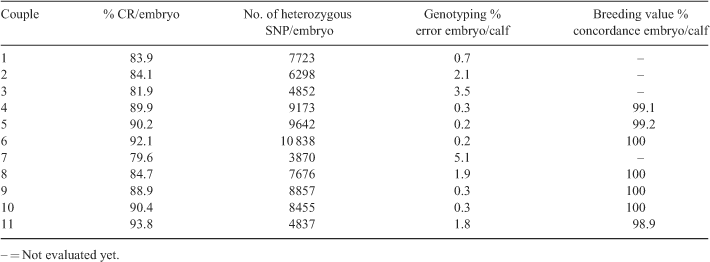135 BREEDING VALUES CONCORDANCE BETWEEN EMBRYOS AND CORRESPONDING CALVES
D. Le Bourhis A , E. Mullaart B , C. Schrooten B , S. Fritz C , W. Coppieters D and C. Ponsart AA UNCEIA, R&D, 94704, Maisons Alfort, France;
B CRV, R&D, P.O. Box 454, 6800 AL Arnhem, the Netherlands;
C UNCEIA, Service Génétique, 75595, Paris, France;
D GIGA-Research, Unit of Animal Genomic, University of Liège, Belgium
Reproduction, Fertility and Development 24(1) 180-180 https://doi.org/10.1071/RDv24n1Ab135
Published: 6 December 2011
Abstract
Genomic tools are now available for most livestock species and are used routinely for genomic selection in cattle. Recently, biopsies of pre-implantation-stage embryos were genotyped for multiple markers. This strategy provides the opportunity to estimate breeding values for traits of particular interest and the presence of genetic abnormalities, thus allowing selection of embryos before transfer (Le Bourhis et al. 2011 Reprod. Fertil. Dev. 23, 197 abst). The present work aimed to compare the genotype and the breeding values from biopsied bovine embryos with the corresponding calves. Bovine embryos were obtained after superovulation (8 cows) and flushing at Day 6 or 7. A total of 11 embryos (1 or 2 Grade 1 embryos per flush per cow) were washed and biopsied using a microblade. Biopsies of 5 to 10 cells were transferred individually as dry samples in tubes and frozen before whole genome amplification (WGA). The genomic DNA of each biopsy was amplified using a WGA kit according to the manufacturer's instructions (WGA; QIAGEN REPLI-g® Mini Kit, Qiagen, Valencia, CA, USA). Biopsied embryos were transferred either frozen or fresh to synchronized recipients. At birth a blood sample was taken from the calf for subsequent genotyping. Genotyping was done using the Illumina BovineSNP50TM beadchip. Only embryos with call rate (CR) higher than 80% were selected for breeding values comparisons. Because of allele dropout, heterozygous markers are turned into homozygous makers artificially. Only markers that were still heterozygous in genotypes of an embryo were selected and error rates were calculated with the same markers from the corresponding calf. Imputation was done using Beagle and taking into account the 50 k genotyping results of the parents. Breeding values (milk production and morphological traits) were calculated and compared with those of the 7 corresponding calves. From 11 embryos analysed, only 1 (9%) gave a CR lower than 80% and a higher percentage error with calf genotype (Table 1). These results indicate that, using embryonic DNA after WGA, genotyping errors between embryo and calf are low and correlated with the CR of embryos. For embryos with CR higher than 84, the concordance of genomic values between embryo and calf is very high. More embryo–calf pairs are needed to assess the reliability of this method and to validate the breeding value at the embryo stage. This new technique offers new possibilities in managing breeding schemes by selecting the embryos before transfer.

|


